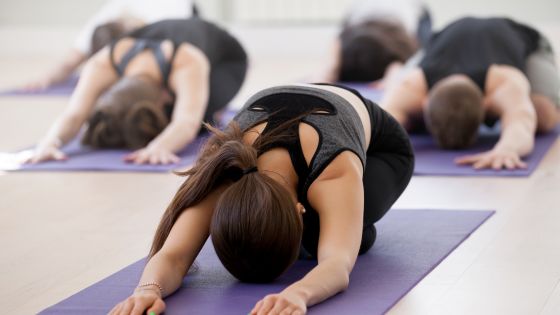Incorporating yoga into your fitness routine for balance and flexibility can be a rewarding and transformative addition and can be highly beneficial for improving balance and flexibility. Yoga is a mind-body practice that combines physical postures, breath control, meditation, and ethical principles. Here’s how it contributes to enhancing balance and flexibility:


Improved Flexibility:
Dynamic Stretching: In yoga, you will engage in a sequence of dynamic stretches that specifically target various muscle groups. By practicing these stretches, you can effectively improve muscle length and flexibility, ultimately enhancing your overall flexibility.
Range of Motion: Through the practice of yoga poses, you can gradually enhance your flexibility by effectively mobilizing your joints and allowing them to move through their complete range of motion.
Enhanced Balance:
Focus on Core Strength: In yoga, special attention is given to the core muscles as they are the key to maintaining balance. By strengthening the core, it not only supports the spine but also improves stability.
Single-Leg Poses: Yoga poses like Tree Pose or Warrior III require you to balance on one leg, which is a great way to improve your proprioception and balance. Incorporating these poses into your practice can be really beneficial.
Mind-Body Connection: The practice of yoga emphasizes the importance of mindfulness and self-awareness. By focusing on your breath and being fully present in every pose, you develop an enhanced sense of body awareness, which is crucial for achieving and sustaining balance.
Stress Reduction:
Relaxed Muscles: Consistent exposure to chronic stress may result in muscle tension and tightness, ultimately hampering flexibility. Nevertheless, incorporating yoga into your routine, with its focus on relaxation and deep breathing, can effectively alleviate tension and promote greater suppleness in your muscles and joints.
Improved Mental Focus: Practicing yoga demands focus and mindfulness, leading to enhanced concentration and coordination in various physical endeavours.
Joint Health:
Fluid Movement: By practicing yoga, you can enjoy the soothing and fluid motions that stimulate the circulation of synovial fluid in your joints. This can effectively improve joint health and reduce any feelings of stiffness.
Isometric Strength: Practicing yoga poses helps to develop isometric strength, which plays a crucial role in stabilizing and safeguarding the joints.
Adaptability to All Fitness Levels:
Modifications and Progressions: In yoga, there are numerous poses available that can be adapted to cater to different fitness levels. As you make progress, you can test your limits by attempting more challenging poses, thereby enhancing your flexibility and balance.
Injury Prevention:
Body Awareness: Practicing yoga cultivates mindfulness of body alignment and movement patterns, effectively reducing the risk of injuries through safe and controlled movements.
Balanced Muscle Development: By practicing yoga, you can achieve a harmonious development of your muscles, preventing any one group from becoming dominant. This balanced growth is crucial in maintaining overall muscle health and reducing the risk of injuries.
A Guide To Help You Seamlessly Integrate Yoga Into Your Fitness Regimen:
- Start with Beginner Classes: If you are a beginner in the world of yoga, it is advisable to join beginner or gentle yoga classes. These classes are specially designed to teach you foundational poses and help you ease into the practice at your own pace.
- Consistency is Key: Regular practice is the key to getting the most out of yoga. Try to schedule at least 2-3 sessions per week to experience significant enhancements in your balance and flexibility.
- Focus on Alignment: Always be mindful of proper alignment in each pose. This not only keeps you safe but also optimizes the benefits you receive from practicing each pose.
- Warm-Up Adequately: Begin your yoga session by gently warming up your body to get ready for more intense stretches. Sun Salutations are an excellent choice to warm up your entire body.
- Work on Your Breath: Remember to focus on your breath and engage in deep, mindful breathing. By synchronizing your breath with your movements, you can strengthen the connection between your mind and body, ultimately relieving any built-up tension.
- Progress Gradually: Do not exert excessive pressure on yourself, particularly in the initial stages. Pay attention to your body’s signals and take small steps forward. As your strength and flexibility enhance, you can gradually delve into more challenging poses.
- Balance Poses: Enhance your stability and boost your balance by incorporating balance poses like Tree Pose, Warrior III, and Eagle Pose into your practice. These poses will challenge you and gradually improve your balance over time.
- Cool Down and Relaxation: Complete your session by incorporating a cool-down and relaxation poses such as Child’s Pose or Savasana. This will help your body absorb the benefits of your practice and enhance your overall well-being.
- Explore Different Yoga Styles: There are many different types of yoga, each with its own special emphasis. If you’re looking to improve your balance and flexibility, you might want to try out styles such as Hatha, Vinyasa, or Iyengar yoga.
- Combine Yoga with Other Exercises: To achieve a well-rounded fitness routine, it’s great to incorporate other forms of exercise alongside yoga, like strength training or cardiovascular activities. This way, you can enhance your balance and flexibility even further.
- Stay Mindful: Yoga is not solely about the physical postures; it also emphasizes the importance of mindfulness. Stay fully present in your practice and carry the principles of mindfulness with you throughout your daily activities.
- Seek Professional Guidance: Taking classes with a certified yoga instructor, especially in the beginning, is highly recommended. They can offer valuable guidance on correct form, adjustments, and modifications tailored to your specific requirements.
- Listen to Your Body: Always respect the boundaries of your body and avoid pushing yourself too hard, as it may lead to discomfort or pain. Remember, yoga is a journey of self-care and self-exploration.
Don’t forget that progress in yoga takes time, so it’s important to maintain patience and embrace the journey with enthusiasm. By regularly integrating yoga into your fitness routine, you’ll witness improvements in both your balance and flexibility, along with enjoying various mental and emotional advantages. The harmonious blend of physical postures, breath control, and mindfulness creates a comprehensive practice that benefits both your body and mind.
















